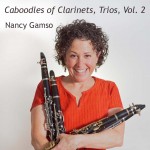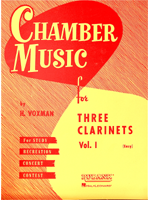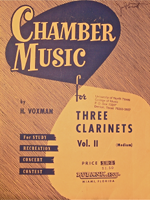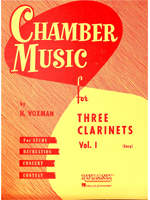Caboodles of Clarinets, Trios, Vol. 2
These trios for three B♭ clarinets are appropriate for intermediate to advanced clarinetists and also work well for casual classical gigs, sight-reading and adult amateurs. All of the selections in this volume are from two publications, Rubank Chamber Music For Three Clarinets, Vols. 1 & 2. Complete publishing information can be found below.
Tracks for each piece below are available separately as high-quality mp3 files.
Or, download the entire set (single zip file): Clarinet-Trios-Vol.-2
Himie Voxman, Chamber Music for Three Clarinets, Vol. I (Easy), Rubank/Hal Leonard, HL04474550
Faber, March from Partita in F
Faber, Minuet I from Partita in F
Faber, Minuet II from Partita in F
Composer Highlights
Practice Suggestions
Faber, Minuet I: Just as there was a slow-beat feel in the march, I like to have the rhythmic feel of this minuet to be in both three and one. I set the tempo around 126 to the quarter, but it can work slower. Minuets were traditionally very busy dances, lots of fancy footwork clicking heels and such, so the tempos probably weren’t too fast in Faber’s day. I also added crescendo-decrescendo markings every four measures from the beginning through m. 16.
Faber, Minuet II: This minuet also has a rhythmic feel in one and four-measure phrasing, crescendo-decrescendos added. Did you notice the short canon (imitation, similar to a round) in mm. 17-22? It’s a nice change of texture and gives this minuet a unique aspect.
Download Tracks
01-Faber March from Partita in F Chamber Music for 3 Clarinets Vol I complete version
02-Faber March from Partita in F Chamber Music for 3 Clarinets Vol I minus 1st part
03-Faber March from Partita in F Chamber Music for 3 Clarinets Vol I minus 2nd part
04-Faber March from Partita in F Chamber Music for 3 Clarinets Vol I minus 3rd part
05-Faber Minuet I Partita in F Chamber Music for 3 Clarinets Vol I complete version
06-Faber Minuet I from Partita in F Chamber Music for 3 Clarinets Vol I minus 1st part
07-Faber Minuet I from Partita in F Chamber Music for 3 Clarinets Vol I minus 2nd part
08-Faber Minuet I from Partita in F Chamber Music for 3 Clarinets Vol I minus 3rd part
09-Faber Minuet II from Partita in F Chamber Music for 3 Clarinets Vol I complete version
10-Faber Minuet II from Partita in F Chamber Music for 3 Clarinets Vol I minus 1st part
11-Faber Minuet II from Partita in F Chamber Music for 3 Clarinets Vol I minus 2nd part
12-Faber Minuet II from Partita in F Chamber Music for 3 Clarinets Vol I minus 3rd part
Download all twelve tracks (single zip file)
Hummel, Ecossaise
Composer Highlights
Ecossaise (French term for ‘Scottish’), in the late 1700s in France, was the term usually applied to a popular contradanse that has a Scottish or British Isles flavor. Beethoven and Schubert wrote them and many western Europeans danced the ecossaise. I found this short work among a collection of Hummel’s, titled Six Very Easy Pieces, Op. 52, which was composed in 1811. The ‘Ecossaise’ is No. 5 and is now available in volume three of a publication that boasts of being the first complete collection of Hummel’s piano music, Johann Nepomuk Hummel (1778-1837) The Complete Works for Piano, A Six-Volume Collection of Reprints and Facsimiles, edited with introductions by Joel Sachs, The Julliard School. Here is photo of the title page of Six Very Easy Pieces, Op. 52. I do love the script!
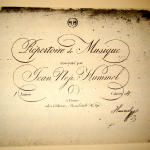
Practice Suggestions
Download Tracks
13-Hummel Ecossaise Chamber Music for 3 Clarinets Vol I complete version
14-Hummel Ecossaise Chamber Music for 3 Clarinets Vol I minus 1st part
15-Hummel Ecossaise Chamber Music for 3 Clarinets Vol I minus 2nd part
16-Hummel Ecossaise Chamber Music for 3 Clarinets Vol I minus 3rd part
Download all four tracks (single zip file)
Mozart, Menuet from Divertimento II
Composer Highlights
Wolfgang Amadeus, Mozart (1756-1891) What can I add to Mozart’s famous story? Well, we can notice that fabulous name –– Johannes Christostomus Wolfgangus Theophilus Mozart (Mozart himself took to the Latin translation of Theophilus: Amadeus, Amadé or Gottlieb for casual occasions). Do you think his parents just couldn’t decide? Let’s remember that Wolfgang was an extremely talented musician from birth with a wealth of training and experience in music from a very early age. His ability to hear and recall music with the accuracy of a recording device meant that his absorption of all the performances he heard on his tours of Europe and Great Britain was so complete, that his style not only came to embody the best of what we now call the ‘Common Practice Period’ but went beyond in innovative and remarkable new directions.These are the first two movements of the five-movement Divertimento No. 2, which is listed either as K.V.Anh. 229, No. 2 or NMA (Neue Mozart-Ausgabe) Series VIII/21 No. 2. The original instrumentation is listed as two oboes and bassoon in one reliable source and as a trio of basset horns in another. (A basset horn is a sort of alto clarinet, pitched in F, although much easier to play and sounds wonderful in all ranges, unlike the alto clarinet; however, the alto clarinet is making a comeback as a jazz instrument). The K.V.Anh. basically translates to ‘Mr. Köchel decided that this was probably composed by Mozart and added it later to the appendix of his Mozart catalog’. Here’s the NMA score. When you click the link below you will choose the following:
- choose your preference for English or German (top right of screen)
- choose the ‘+’ sign next to Series VIII: Chamber Music
- choose the quarter-note icon to the right of NMA VIII/21: Duos and Trios for Strings and Woodwind Instruments
- enter 79 in the ‘find page no.’ box. The minuetto is about half way down the page. Here’s the website.
Practice Suggestions
Download Tracks
17-Mozart Menuet from Div II Chamber Music for 3 Clarinets Vol I complete version
18-Mozart Menuet from Div II Chamber Music for 3 Clarinets Vol I minus 1st part
19-Mozart Menuet from Div II Chamber Music for 3 Clarinets Vol I minus 2nd part
20-Mozart Menuet from Div II Chamber Music for 3 Clarinets Vol I minus 3rd part
Download all four tracks (single zip file)
Mozart, Minuetto and Trio from Divertimento III
Composer Highlights
Wolfgang Amadeus, Mozart (1756-1891) What can I add to Mozart’s famous story? Well, we can notice that fabulous name –– Johannes Christostomus Wolfgangus Theophilus Mozart (Mozart himself took to the Latin translation of Theophilus: Amadeus, Amadé or Gottlieb for casual occasions). Do you think his parents just couldn’t decide? Let’s remember that Wolfgang was an extremely talented musician from birth with a wealth of training and experience in music from a very early age. His ability to hear and recall music with the accuracy of a recording device meant that his absorption of all the performances he heard on his tours of Europe and Great Britain was so complete, that his style not only came to embody the best of what we now call the ‘Common Practice Period’ but went beyond in innovative and remarkable new directions.J.C.W.T. (A.) Mozart wrote lots of divertimenti for all kinds of instruments and special events. Some were written for installing royalty, for university finals, for thanking a prince for offering an unpaid job, and many, many more dubious reasons. This one is Divertimento III, KV 439, No. 3. In the NMA (Neue Mozarteum-Ausgabe) you can find it by just looking in the drop down for “Series VIII: Chamber Music” and choose the note icon to the right of “NMA VIII/21: Duos and Trios for Strings and Woodwind Instruments”. This menuetto/trio is found on pp. 96-99. Here is the link to the NMA site and directions to navigate to this work:
- choose your preference for English or German (top right of screen)
- choose the ‘+’ sign next to Series VIII: Chamber Music
- choose the quarter-note icon to the right of NMA VIII/21: Duos and Trios for Strings and Woodwind Instruments
- enter 96 in the ‘find page no.’ box. Here’s the website.
Practice Suggestions
Download Tracks
21-Mozart Minuetto and Trio Div III Chamber Music for 3 Clarinets Vol II complete version
22-Mozart Minuetto and Trio Div III Chamber Music for 3 Clarinets Vol II minus 1st part
23-Mozart Minuetto and Trio Div III Chamber Music for 3 Clarinets Vol II minus 2nd part
24-Mozart Minuetto and Trio Div III Chamber Music for 3 Clarinets Vol II minus 3rd part
Download all four tracks (single zip file)
Mozart, Rondo from Divertimento IV
Composer Highlights
Wolfgang Amadeus, Mozart (1756-1891) What can I add to Mozart’s famous story? Well, we can notice that fabulous name –– Johannes Christostomus Wolfgangus Theophilus Mozart (Mozart himself took to the Latin translation of Theophilus: Amadeus, Amadé or Gottlieb for casual occasions). Do you think his parents just couldn’t decide? Let’s remember that Wolfgang was an extremely talented musician from birth with a wealth of training and experience in music from a very early age. His ability to hear and recall music with the accuracy of a recording device meant that his absorption of all the performances he heard on his tours of Europe and Great Britain was so complete, that his style not only came to embody the best of what we now call the ‘Common Practice Period’ but went beyond in innovative and remarkable new directions.Divertimenti were often written as music for special events. Some of the others were written for installing royalty, for university finals, for thanking a prince for offering an unpaid job, and many, many more dubious occasions. This one is Divertimento IV, KV 439, No. 4. Here is the link to the NMA (Neue Mozarteum-Ausgabe) site and directions to navigate to this work:
- choose your preference for English or German (top right of screen)
- choose the ‘+’ sign next to Series VIII: Chamber Music
- choose the quarter-note icon to the right of NMA VIII/21: Duos and Trios for Strings and Woodwind Instruments
- enter 111 in the ‘find page no.’ box. Here’s the website:
Practice Suggestions
Download Tracks
25-Mozart Rondo from Div IV Chamber Music for 3 Clarinets Vol II complete version
26-Mozart Rondo from Div IV Chamber Music for 3 Clarinets Vol II minus 1st part
27-Mozart Rondo from Div IV Chamber Music for 3 Clarinets Vol II minus 2nd part
28-Mozart Rondo from Div IV Chamber Music for 3 Clarinets Vol II minus 3rd part
Download all four tracks (single zip file)
Old English, Drink to Me Only With Thine Eyes
Composer Highlights
Practice Suggestions
Download Tracks
29-Old English Drink to Me Chamber Music for 3 Clarinets Vol I complete version
30-Old English Drink to Me Chamber Music for 3 Clarinets Vol I minus 1st part
31-Old English Drink to Me Chamber Music for 3 Clarinets Vol I minus 2nd part
32-Old English Drink to Me Chamber Music for 3 Clarinets Vol I minus 3rd part
Download all four tracks (single zip file)
Schubert, Entr’acte from Rosamunde
Composer Highlights
Practice Suggestions
Download Tracks
33-Schubert Entracte Chamber Music for 3 Clarinets Vol I complete version
34-Schubert Entracte Chamber Music for 3 Clarinets Vol I minus 1st part
35-Schubert Entracte Chamber Music for 3 Clarinets Vol I minus 2nd part
36-Schubert Entracte Chamber Music for 3 Clarinets Vol I minus 3rd part
Download all four tracks (single zip file)

